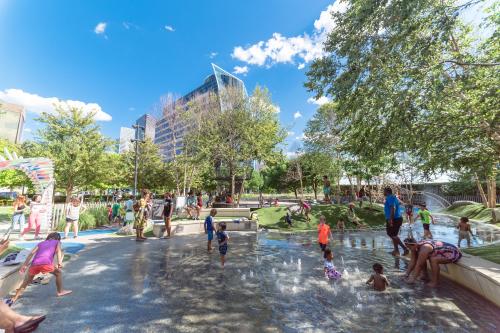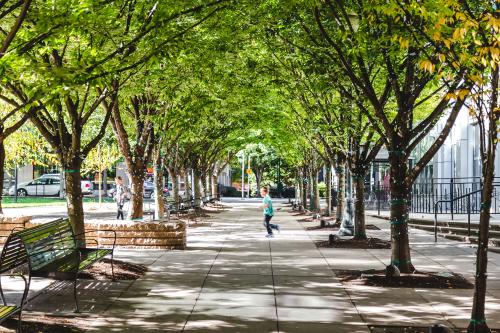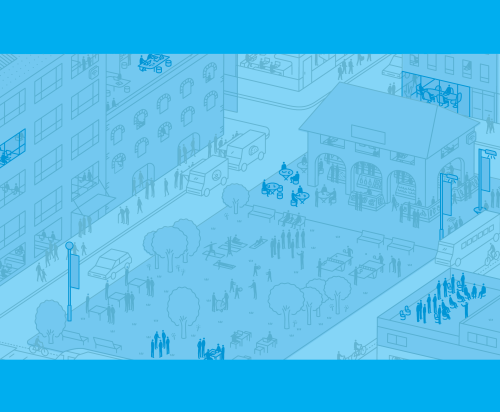Late last month, The Guardian published a piece with the somewhat incendiary title “How placemaking is tearing apart social housing communities.” The article tells a distressing story of a local east London council forcing the relocation of social housing residents so the estate could be refurbished, and how years later, hundreds of units remain empty as displaced residents have yet been able to return. The details as described are a little murky — or perhaps I just got lost in the British English — but the author, Nye Jones, was crystal clear on one point: placemaking was to blame.
Having just launched the new Anne T. and Robert M. Bass Center for Transformative Placemaking, I was understandably anxious about how Jones was defining placemaking, as by the article title alone I was confident he didn’t get it quite right. More than that, I had the foreboding feeling that placemaking might now be on the same slippery linguistic slope as “gentrification” — a word that Jason Segedy, in a recent City Observatory article, suggested has become “useless,” with no agreed upon meaning.
Upon opening The Guardian article, I was even more disheartened to see in the subtitle that Jones was actually conflating the two terms, referring to placemaking as “gentrification by any other name.” Indeed, Jones goes on to say that “placemaking” reflects developers’ quest for culture and luxury whereby social housing tenants are “shooed out of the way” to make room for the affluent. So if I understand correctly, it appears that “placemaking” is now being used — by Jones and others in the UK, anyway — to describe the phenomenon of displacement once connoted by the now meaningless term “gentrification.” Yikes.
The Guardian article notwithstanding, the most commonly cited definitions of placemaking actually hew closely to one another. Project for Public Spaces says that placemaking refers to a “collaborative process by which we can shape our public realm in order to maximize shared value.” Both an outcome and a process, it “facilitates creative patterns of use, paying particular attention to the physical, cultural, and social identities that define a place and support its ongoing evolution.” Placemaking Chicago adds that it involves “looking at, listening to, and asking questions of the people who live, work, and play in a particular space, to discover needs and aspirations.” (Emphasis theirs.) And Robert Steuteville, editor of Congress for the New Urbanism’s (CNU) Public Square, says simply that it is “the process of creating quality places that people want to live, work, play, and learn in.”
Engaging people to create the kinds of places that reflect their identity, vision, needs, and desires is a central placemaking tenet, regardless of the specific words used to define the term.
Any differences in these and other descriptions of placemaking seem largely to be of the “tomato, tomahto” variety. And it’s hard to see how any of them even insidiously imply the “shooing out” of particular groups of residents, as Jones asserts. On the contrary, engaging people to create the kinds of places that reflect their identity, vision, needs, and desires is a central placemaking tenet, regardless of the specific words used to define the term.
So what, then, seems to be the mix up?
I’d argue that placemaking itself isn’t the problem. The real issue is the as yet too-limited reach of its potential impact. This has to do with both the scope as well as the scale of many placemaking efforts. More than that, it has to do with the communities and residents that have often reaped the benefits of such efforts, and those that have been passed over, in some cases, over and over, decade after decade. Put another way, we need more placemaking, not less.
Moving toward transformative placemaking
That’s why we decided to use “transformative placemaking” to describe the focus and work of the new Bass Center. While it may appear to be just a jargon-y phrase among other jargon-y phrases (“strategic placemaking,” “creative placemaking,” and “tactical placemaking” among them), our purpose was to extend its meaning to encompass a broader set of outcomes (scope), affect larger geographic areas (scale), and promote practices and policies that benefit more people and communities.
First, transformative placemaking suggests a set of investments in both physical design and programs that not only create safe, attractive, socially interactive places where people want to “live, work, play, and learn” but which also empower broad and diverse networks of local entrepreneurs, community organizations, institutions, and workers to spur creativity, business development, and job growth. In short, it’s about expanding the scope of placemaking to include efforts aimed not only at improving our social, emotional, and physical well-being, but at remaking the relationship of place and economy in ways that generate widespread, and locally-led, prosperity.
Rather than misguidedly condemning placemaking, we need to be far more bullish about advancing placemaking efforts that benefit existing residents and workers.
Second, transformative placemaking suggests investments focused not only on design and programming of individual lots, plazas, or even blocks, but of “economic districts” — sub-areas of regions where a critical mass of economic assets cluster and connect. This is the scale at which transformative outcomes like those described above can be realized — where shared values and ambitions can be articulated and actualized through holistic, integrated strategies designed by and for the stakeholders in that community (possibly via new place-based governance structures).
Finally, transformative placemaking suggests that such investments be made not only in downtowns, waterfronts, and other high-amenity, often highly-resourced areas, but in districts where concentrations of human capital, physical, and economic assets have long been overlooked and undervalued by both the private and public sectors. These areas, too, may have hospital systems and universities, global firms and clusters of locally grown businesses, and strong civic structures. They may have a walkable street grid, a historic Main Street or commercial corridor, and public transit access. Most importantly, they are the home or workplaces of people who must not simply be active participants in, but rather the drivers of, growth and opportunity. Their leadership, ideas, and talents need to be recognized and supported if our cities and towns are to overcome the discriminatory policies of the past (and present) — and have any hope of succeeding in a rapidly changing economy and diversifying society.
If done well, transformative placemaking will inevitably generate the kind of improvements that bring in new businesses, workers, and residents, and drive up real estate values in the process. But suggesting this is a reason not to make such improvements is, in the words of the folks at State of Place, “fundamentally myopic, counterproductive, and borderline condescending” to the people who need and deserve quality investments that help foster economic growth and opportunity. Rather than misguidedly condemning placemaking, we need to be far more bullish about advancing placemaking efforts that benefit existing residents and workers — while also employing housing, economic development, workforce, and social policies and practices that do the same. This is what transformative placemaking means. It isn’t about replacing one thing or group for another. Rather, it’s about building upon all that’s already there to make a place stronger and more durable than it was before.







Commentary
How placemaking can empower urban communities, not tear them apart
January 16, 2019